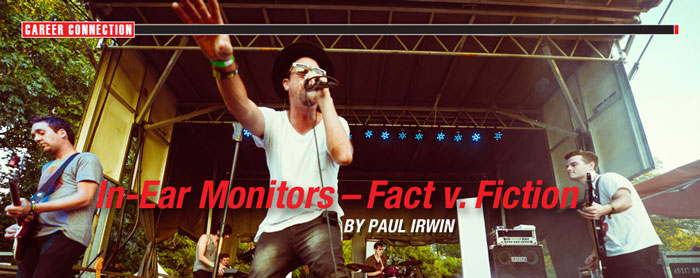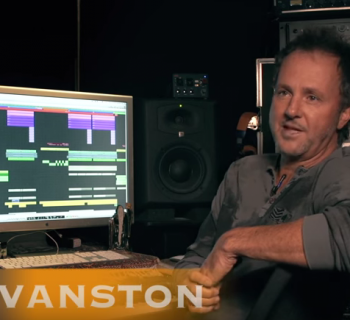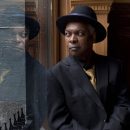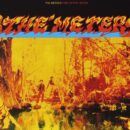I have good news. It doesn’t matter anymore whether you like or use wedge monitors or in-ears. As long as you wear electronic earplugs when using wedges, you’re good. You’ll be able to hear everything from the plaintiff cries of adoring fans in the front row to the keyboard player way stage right and not feel like your head is stuffed with cotton the next morning (and you’ve likely suffered the incremental, cumulative and irreversible hearing loss that has robbed Pete Townsend of a most precious sense in his dotage). And, if your front-of-house guy or gal can be made to mic the crowd and include it in the monitor mix coming through your in-ears, you lose nothing by wearing them. With today’s technology, it’s entirely up to you.
Clearly, however, IEM’s allow for pinpoint control of what you hear on stage. And, while they take a little getting used to (if you’re new to the gear), the ability to put a fine tune on your mix is so worth it. After that, it’s about cost. Most stages come with wedges at no cost to you, although every stage is different and there’s the issue of consistency from venue to venue to consider.
Using backing tracks and/or a click track? Better to use the in-ears. However, if you choose to use them, you need to come equipped with in-ears—unless you’re Steven Tyler and can walk in naked and charge every piece of gear and creature comfort you can think of to the tour or promoter. For argument’s sake, let’s just say you’re not Steven.
Designated Drivers
Walk with me and talk with Rick Carlson, Etymotic Research’s Manager of Product Training and Customer Service, as we sort a few in-ear myths and legends.
Music Connection: In-ears can be super-expensive right? Taylor Swift has sparkly ones that look like they cost a fortune.
Rick Carlson: Not necessarily. While you’ll see plenty of high profile musicians using rather expensive custom-fitted in-ear monitors, you can get the same benefits using a set of noise-isolating earphones with universal-fit eartips. Our mc5 earphone is a good example. You can get the benefits of 35-42dB of noise isolation and accurate sound reproduction for $59.
MC: Okay, but a star like Ms. Swift can afford the best. They cost a lot more so they must be better in some way, no?
Carlson: The in-ear monitors that you’ll see the big stars wearing are often custom-fitted to the musician’s ears and may utilize multiple balanced-armature drivers. These features will drive up the cost considerably.
MC: And you’re really saying that there’s no real benefit whatsoever to in-ears that cost five figures and in-ears like Etymotic’s ER-4’s, or even your least expensive mc5’s, for example.
Carlson: Well, let’s put it this way: Etymotic approaches earphones in terms of accurate sound reproduction, so that what you hear is as true to the source as possible. We have yet to see any evidence that adding multiple drivers does anything to improve the accuracy score of an earphone. When I talk to customers about in-ears and choices on the market, I’ll ask them: why do you need multiple drivers to fill a tiny space such as your ear canal? Adding additional drivers also increases the output capability of an in-ear monitor. Do you really want to put something in your ear that could potentially output 130 dB or greater?
MC: And what about the custom molds? Those must cost a bunch and be a pain (literally) to get fitted for…
Carlson: There are benefits to having custom earmolds, primarily for comfort and the ability to enjoy a consistent fit and seal, and getting ear impressions is not a painful experience at all. Etymotic certainly recognizes this, which is why we offer a Custom Fit Program for our earphones. However, custom earmolds aren’t necessarily fool-proof. Pay close attention to some of the folks onstage and you might catch them adjusting the fit of their custom earmolds mid-performance because they’re not sealing properly. Remember that custom earmolds are only as good as their initial ear impressions. Sometimes they need to be remade several times until the fit is just right.
MC: There’s also the cost of a wireless pack and the risk of interference. Nothing like picking up police calls through the PA in the middle of your best ballad….
Carlson: If you decide to go wireless, you’ll certainly face some challenges and additional expense. You’ll want to have a good monitor engineer.
MC: Okay, but let’s just say that my guitar players are addicted to wedges, and making those guys go cold turkey scares me. What’s this about using electronic earplugs on stage?
Carlson: There are many bands playing in venues where in-ear monitors just aren’t an option. Electronic Earplugs like Etymotic’s MusicPRO 9-15 series are often an ideal solution. Not only are you reducing loud, constant noise to safer levels, but they allow you to hear quiet passages and communicate onstage without having to remove the earplugs from your ears. Plus, they offer a blast-protection element to protect against sudden, extreme loud sounds like a burst of feedback, pyrotechnics, or the cymbal crash from an over-zealous drummer.
MC: So, going back to IEM’s, you’re saying that custom molds cost less than the band’s beer bill, the fittings are a breeze, and some very high-profile acts are using Ety’s ready-fit tips right out of the box, so it’s really a matter of personal preference. You’re saying that a well-balanced earphone will protect my hearing and give me a more accurate mix (as long as the engineer knows what he or she is doing) than wedge monitors.
Carlson: Did I really say all of that? I’ll definitely agree with the second part: that a well-balanced (i.e., neutral) noise-isolating earphone can help protect your hearing on stage and let you hear more of what you need to hear, whether it’s your own instrument, vocals, etcetera.
Well, there you have it. It’ll take a bit of doing to select the pair of in-ears you like best, but start by checking the ratings for accuracy. You want to hear what’s coming out of the board and not through earphones overloaded with bass, for example. Highly accurate earphones can be had for the same economical price as those that are juiced, so go with a pair that’s sonically “true.” Then, all you need is that talented monitor engineer. Good luck!
PAUL IRWIN has been writing the In Tune Listening List and Frontrunner column for In Tune Monthly magazine for over a decade. He also records the Listening List podcast on intunemonthly.com, contributes the “Songs We Like” column for the Etymotic AudioFile e-newsletter and contributes to MusicAlive! magazine, among others.











